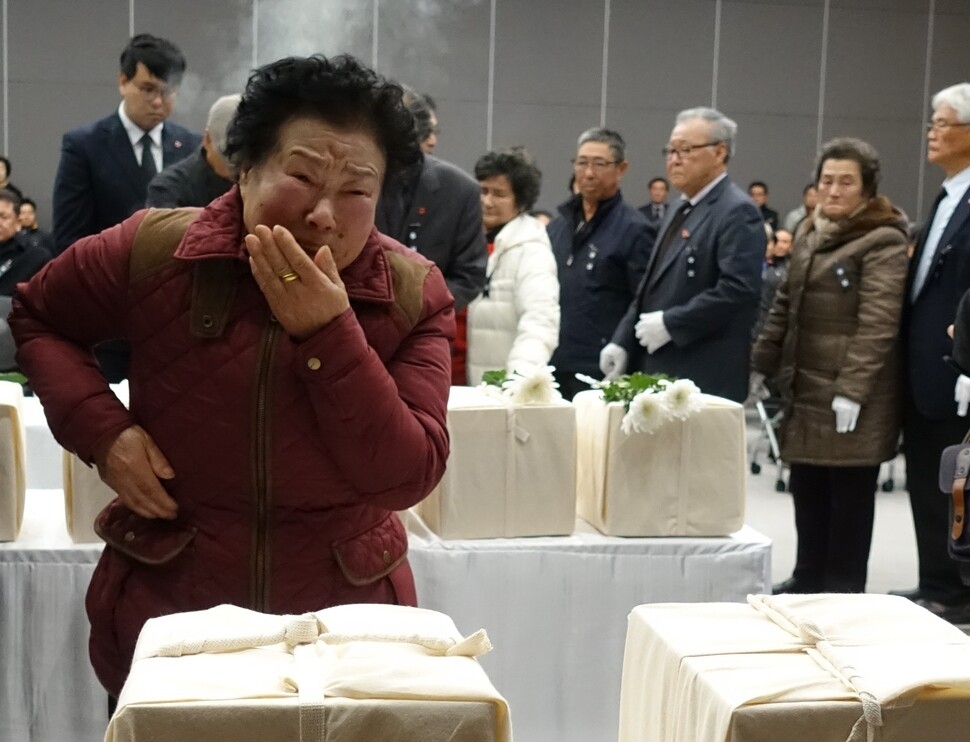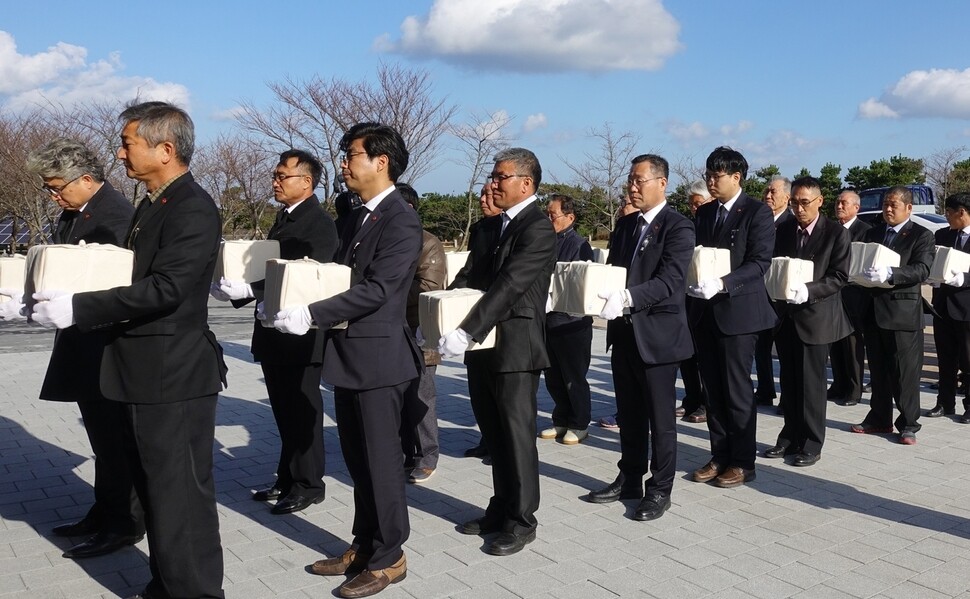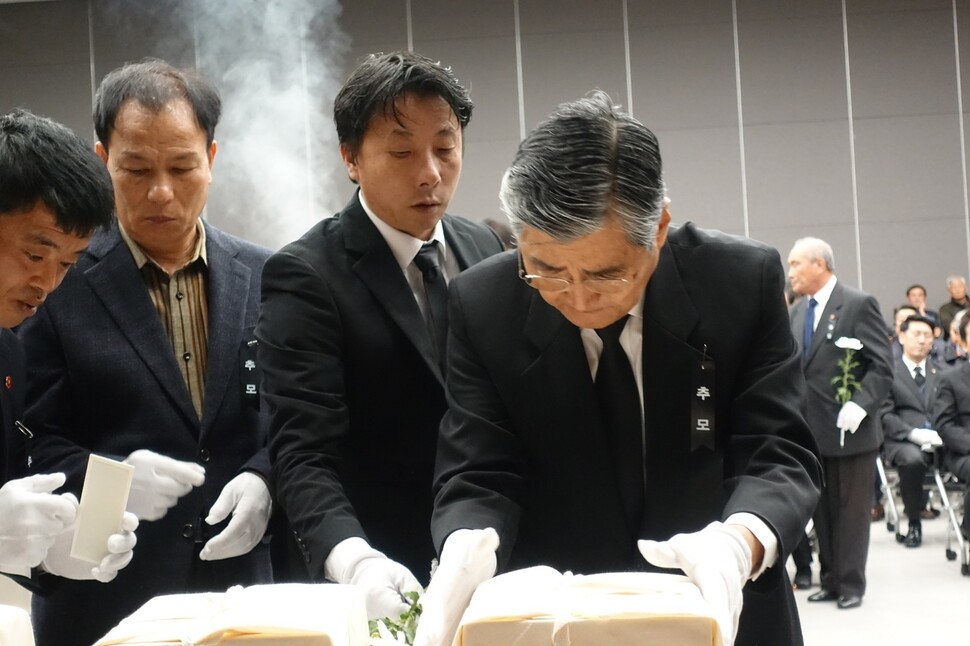hankyoreh
Links to other country sites 다른 나라 사이트 링크
29 sets of remains of Jeju Uprising victims housed at charnel house after 70 years

“Father, there’s no telling how long it’s been since I called you that. This may even be the first time.”
A woman in her seventies sobbed as the clutched a box of remains that was draped in a white cotton cloth.
On the morning of Nov. 22, tears flowed freely at the Peace Education Center at the Jeju Apr. 3 Peace Park, located in the Bonggae neighborhood of Jeju City. The autumn sky above the island was bright blue, but the scene inside the education center was quite different: the air was heavy with smoke rising from incense sticks and filled with the sobbing and wailing of mourners.
The education center was the site of a ceremony jointly hosted by the Jeju Island government, the Jeju Apr. 3 Peace Foundation and the Association for the Bereaved Families of Apr. 3 Victims in honor of 29 victims of the Jeju Uprising. They are some of the people who have been identified after their remains were dug up at Jeju Airport between 2007 and 2009.

Remains unidentified for more than 10 years due to lack of funding
Though more than a decade has passed since the remains were recovered, they had not been identified previously because no funding had been allocated during the presidencies of Lee Myung-bak and Park Geun-hye. But after Moon Jae-in became president, the government earmarked 1.2 billion won (US$1.06 million) of funding that enabled the identification work to proceed this year.
A total of 404 remains of victims of the Jeju Uprising were dug up in the area around Jeju Airport between 2007 and 2009, and 121 have been identified so far, including the 29 who were honored in the ceremony on Thursday. The remains belonged to Jeju residents who were killed while being held in preventive detention following the court martials in Oct. 1949 and the Korean War.

Yang Bok-hui, 77, who lost her older brother Maeng-suk during the Jeju Uprising, remembers her brother giving her a ride on his shoulders more than 70 years ago. “I just feel sorry it took so long to find him,” she said, wiping tears from her eyes.
Kim Sang-ho, from the Jungmun neighborhood of Seogwipo, was reunited with his father’s remains. “I can hardly believe I’ve found my father’s remains 68 years later. In my dreams tonight, I hope I can see my father so that I can hold his hands and tell him I know what he went through,” Kim said.
Kang In-seon, 86, came with his two younger sisters from their home in the Seohong neighborhood of Seogwipo. “When I was 11 years old, my father was taken to the police station in our town. I remember going all the way there and throwing myself on the ground and begging them not to take my father away,” Kang said.

Yang Yu-gil, 82, used to weep bitterly while looking for her older brother at the dig at Jeju Airport. Finding her brother has helped eased her sorrow.
The remains of the victims will be housed at a charnel house at the Jeju Apr. 3 Peace Park.
More funding from the government is needed to confirm the identities of the remaining victims.
“Last year, a woman who was waiting for her husband [to be identified] passed away. Identifying more of the remains that have been recovered and sending them to be with their families is the right thing to do,” said Oh Im-jong, vice chair of the Association for the Bereaved Families of Apr. 3 Victims.
By Huh Ho-joon, Jeju correspondent
Please direct comments or questions to [english@hani.co.kr]

Editorial・opinion
![[Guest essay] The real reason Korea’s new right wants to dub Rhee a founding father [Guest essay] The real reason Korea’s new right wants to dub Rhee a founding father](https://flexible.img.hani.co.kr/flexible/normal/500/300/imgdb/original/2024/0423/8317138574257878.jpg) [Guest essay] The real reason Korea’s new right wants to dub Rhee a founding father
[Guest essay] The real reason Korea’s new right wants to dub Rhee a founding father![[Column] ‘Choson’: Is it time we start referring to N. Korea in its own terms? [Column] ‘Choson’: Is it time we start referring to N. Korea in its own terms?](https://flexible.img.hani.co.kr/flexible/normal/500/300/imgdb/original/2024/0423/3617138579390322.jpg) [Column] ‘Choson’: Is it time we start referring to N. Korea in its own terms?
[Column] ‘Choson’: Is it time we start referring to N. Korea in its own terms?- [Editorial] Japan’s rewriting of history with Korea has gone too far
- [Column] The president’s questionable capacity for dialogue
- [Column] Are chaebol firms just pizza pies for families to divvy up as they please?
- [Column] Has Korea, too, crossed the Rubicon on China?
- [Correspondent’s column] In Japan’s alliance with US, echoes of its past alliances with UK
- [Editorial] Does Yoon think the Korean public is wrong?
- [Editorial] As it bolsters its alliance with US, Japan must be accountable for past
- [Guest essay] Amending the Constitution is Yoon’s key to leaving office in public’s good graces
Most viewed articles
- 1[Editorial] Japan’s rewriting of history with Korea has gone too far
- 2Samsung barricades office as unionized workers strike for better conditions
- 3[Column] ‘Choson’: Is it time we start referring to N. Korea in its own terms?
- 4Why Korea shouldn’t welcome Japan’s newly beefed up defense cooperation with US
- 5[Column] The clock is ticking for Korea’s first lady
- 6[Guest essay] The real reason Korea’s new right wants to dub Rhee a founding father
- 7Korean government’s compromise plan for medical reform swiftly rejected by doctors
- 8[Reporter’s notebook] Did playing favorites with US, Japan fail to earn Yoon a G7 summit invite?
- 9[Column] The president’s questionable capacity for dialogue
- 10Senior doctors cut hours, prepare to resign as government refuses to scrap medical reform plan